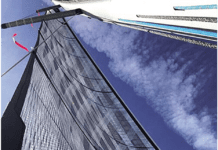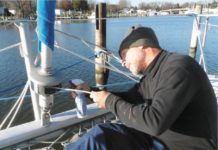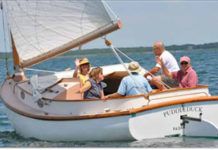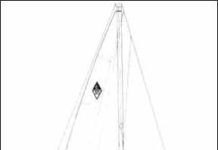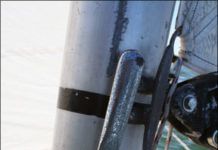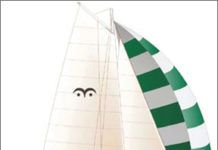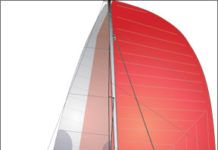The San Juan 24
In the late 1960s and early 1970s, the Clark Boat Co. jumped on the trailer sailer bandwagon, and became a successful player in this decade-long market. Earlier, Bob and Carol Clark built Lightnings and ThistIes, and later, with the business in the hands of their son Don, the company built boats as large as 34 feet. The last boats came out of the shop in 1986, the year the company went out of business. While the San Juan 21 trailer sailer really established the Clark Boat Co., it was the more performance-oriented boats such as the San Juan 24 and 7.7 that gave it the reputation of a successful builder of faster, under-3D-foot boats.
Boat Review: Marshall 22 Catboat
The stout Marshall 22, in production since 1965, rekindles the romance of shoal-water sailing. As a weekender or coastal cruiser, the Marshall has much to recommend it, especially to those who can fully exploit its shallow draft. Drawing less than 6 feet, the Marshall opens up new cruising grounds for those willing to put in a little extra effort. New boat prices range from the base $76,900 to around $90,000. Used boats range from around $18,000 to $70,000. Practical Sailor recommends a survey for the purchase of all used boats.
PS Reviews the Presto 30 Trailer-sailer
Rodger Martin’s Presto 30 is clearly a descendant of the round-bilge sharpies made famous by Ralph Munroe’s Presto and Egret. The origins of the hull and rig date back to a classic American oyster-tonging boat, the New Haven sharpie, which first appeared in Long Island Sound around 1850. Martin wanted the Presto 30 design details to include trailerability and shallow draft. The Presto is 30 feet long and 8 feet, 6 inches wide. With the centerboard up, it draws just 13 inches; with the centerboard extended, it draws 5 feet, 6 inches. The 320 feet of sail area is evenly divided between two sails set on wishbone booms, and while the designer calls it a schooner rig, the maker, Ryder Boats, has deemed it a cat-ketch rig. The Presto’s 1,000 pounds of lead shot in the keel help address this shoal-draft weekener's tender handicap, but like any shallow-water boat, the Presto will need to be actively sailed in a blow.
Construction Details Presto 30
Built by Ryder Boats in Bucksport, Maine, the Presto 30 is a lightweight performance craft built with modern composite construction and assembly techniques.
Improve Your Catalina 30: Upgrading the World’s Most Popular 30-Footer
The Catalina 30 is a remarkable success story. We suspect that more Catalina 30s have been built than any other boat of that size anywhere in the world. While the basic boat has remained unchanged since it was introduced in 1975, there have been dozens, perhaps even hundreds, of minor developments in the boat in the course of a production run that is approaching 4,000 hulls. The advantage of a boat in production for so long is a high degree of product refinement over the years. The challenge for the owner of an early version of the boat is to upgrade his boat to the standards of models currently in production.
Improve Your Catalina 30: Upgrading the Worlds Most Popular 30-Footer
The Catalina 30 is a remarkable success story. We suspect that more Catalina 30s have been built than any other boat of that size anywhere in the world. While the basic boat has remained unchanged since it was introduced in1975, there have been dozens, perhaps even hundreds, of minor developments in the boat in the course of a production run that is approaching 4,000 hulls.
Mast Support for Trailerable Boats
On most trailerable boats, when the mast is stowed for travel it is lashed to the bow pulpit and stern rail with no support at all in the middle.
International Folkboat – a Classic Pocket-cruiser: Used Boat Review
The Tord Sunden-designed Swede classic, the International Folkboat, shares many of the same features as the Nordic Folkboat: the displacement and sail area are the same, the shallow drafts are similar, and the $10,000-price tag runs about equal. The IF, though, has done away with Nordic Folkboat clinker hull, the Nordic’s reverse transom has been cut short, and the IF’s shallow self-draining cockpit replaces the Nordic’s deep well. The most notable difference is that the IF is fiberglass. This well-made boat with a loyal following performs well under blustery conditions, and remains popular with coastal cruisers and weekenders.
Tiki 30 Catamaran: A Practical Sailor Boat Test
Practical Sailor reviews a custom, backyard-built Tiki 30, a wood boat designed by cat-cult hero James Wharram (www.wharram.com) and built by bluewater voyager Dave Martin. Like most of Wharram's designs, testers found, the real genius in the Tiki 30 comes more from whats not found than whats present on board. No lead, no liners, and no inboard engine adds up to a displacement that is so light that a low-tech, no-boom small sail plan can provide enough drive to make way. In light zephyrs, this agile cat will tack and make progress to windward. Not only is the light-air cruiser efficient under sail, but it's also efficient to build. The price point is attractive, as long as one views the labor commitment as part of the recreational experience. But when all the glue and paint has finally cured, the bottom line is that the Tiki 30 is best suited to cruisers willing to slip away without huge battery banks or large-volume tanks, and with less mechanical propulsion reliance.
New J/95 Centerboard Sailboat is Fit for Shallow Water
Introduced last year, the sleek J/95 is a lightweight, 30-foot sloop with a plumb bow, a bronze centerboard, twin rudders, and a Spartan interior. The J/95 is the brainchild of Rod Johnstone and is built by C&C Fiberglass Composites (CCFC) in Bristol, Rhode Island. An ideal option for baby boomers settling in the shallow estuary areas of the Carolinas and Southwest Florida, the race-ready J/95 is a high performance daysailer thats fun and easy to sail right off the dock. It also offers the potential to take off as a one-design race boat.













